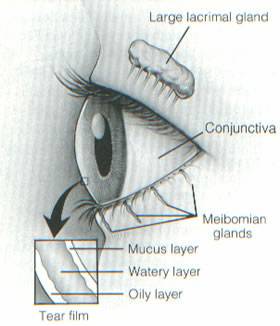
DRY EYE SYNDROME
What is dry eye syndrome?
How does it occur?
Normally, your body produces two types of tears:
- Lubricating tears, which are produced all the time. They help keep your eyes moist and clean and help fight infection. The tear film that forms contains layers of water, mucus, and oil. Dry eye can occur when any one of these layers is not normal. Most often, the watery layer is too thin.
- Reflex tears, which are produced in response to injury, irritation (such as smoke or toxic chemicals), or emotion. They may even be produced in response to dry eye, when your eyes lack lubricating tears, so your eyes may be more watery than normal.

Dry eye may be caused by:
- aging
- a dry environment
- medicines
- lack of vitamin A
- diseases such as arthritis, Sjogren's syndrome, Systemic Lupus Erythematosus (SLE), leukemia, and Stevens-Johnson syndrome
- chemical or thermal burns.
What are the symptoms?
Symptoms may include:
- a scratchy, gritty, burning feeling in your eyes
- excessive watering
- stringy mucus in your eyes
- blurring of vision that clears by blinking or closing your eyes.
How is it diagnosed?
Your doctor will examine your eyes and ask about:
- your symptoms
- your environment
- your overall health
- medicines you are taking.
The answers to these questions will help your provider determine if you need other tests..
How is it treated?
There is no cure for dry eye. However, several treatment options are available that can reduce your discomfort and protect your eyes. Usually, your health care provider will recommend that you use eyedrops called artificial tears during the day and sometimes similar ointments at night. If these first-line products do not help, your provider may recommend other treatments.
How can I take care of myself?
- See your health care provider if you have any symptoms of dry eye.
- Follow your health care provider's instructions for controlling your dry eyes.
- Have your eyes checked regularly (at least every 2 or 3 years).
This content is reviewed periodically and is subject to change as new health information becomes available. The information is intended to inform and educate and is not a replacement for medical evaluation, advice, diagnosis or treatment by a healthcare professional.
